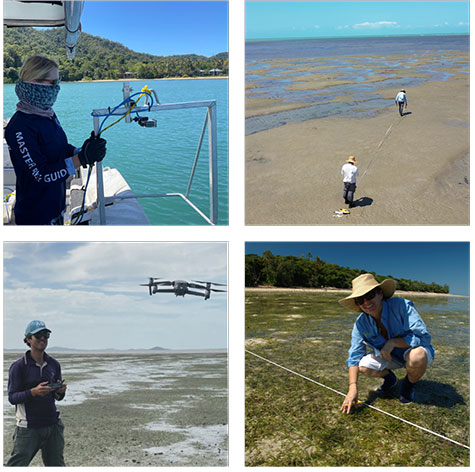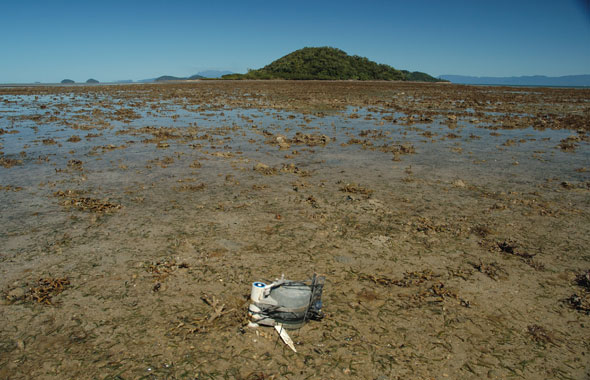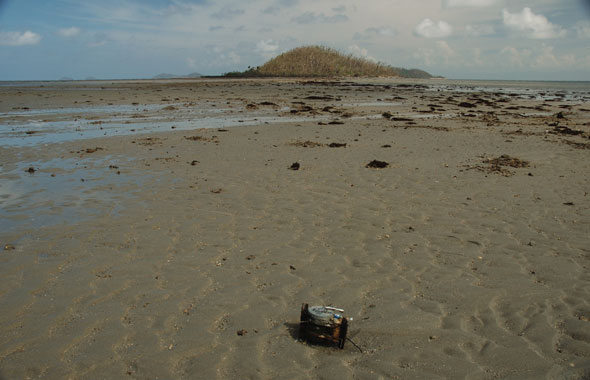MARINE MONITORING PROGRAM
ABOUT THE MARINE MONITORING PROGRAM
The strategic priority for the Great Barrier Reef Marine Park Authority is to sustain the Reef’s outstanding universal value, build resilience and improve ecosystem health over each successive decade. Improving water quality is a key objective, because good water quality aids the resilience of coastal and inshore ecosystems of Reef. In response to concerns about the impact of land-based run-off on water quality, coral and seagrass ecosystems, the Marine Monitoring Program (MMP) was the established in 2005 to monitor the inshore health of the Great Barrier Reef.
A key deliverable of the MMP, is reporting annually on the condition of inshore water quality, coral and seagrass, which forms an integral part of the Paddock to Reef Integrated Monitoring, Modelling and Reporting Program (Paddock to Reef program). The Paddock to Reef program evaluates the efficiency and effectiveness of Reef 2050 Water Quality Improvement Plan implementation, and report on progress towards goals and targets
The overarching objective of the inshore seagrass monitoring program is to quantify the extent, frequency and intensity of acute and chronic impacts on the condition and trend of seagrass meadows and their subsequent recovery.



In late 2008, seagrasses of the GBR were in a moderate state of health. From 2009 with the onset of the La Niña, seagrass state steadily declined due to multiple years of above-average rainfall. By 2010, seagrasses of the Reef were in a poor state and vulnerable to large episodic disturbances, as demonstrated by the widespread and substantial losses documented after the floods and cyclones of February 2011. Onset of seagrass recovery was observed from early 2012.
Seagrass Futures Team (Seagrass-Watch) monitor three indicators of seagrass condition: abundance (percent cover), reproductive effort and leaf tissue nutrients. Additional measures of seagrass condition and resilience include seagrass species composition, relative meadow extent and density of seeds in the seed bank.
Environmental pressures on seagrasses are recorded too, including within-canopy water temperature, within-canopy benthic light, sediment composition, macroalgae and epiphyte abundance.
Seagrass meadows are surveyed late in the dry season and again late in the wet season.
Understanding how the resilience of the Reef is affected by pressures is vital for management. Monitoring the inshore health of the Reef has been routinely carried out since 2005 under this program. Annual monitoring enables us to analyse:
- trends in water quality parameters (turbidity/water clarity, nutrients) relative to the Water Quality Guidelines for the Great Barrier Reef Marine Park
- the ecological risk of mixtures of pesticides to Reef ecosystems
wet-season river-derived pollutant exposure - inshore seagrass condition and ecosystem health
The information collected is used for tactical, operational and strategic planning, quantifying management effectiveness and reporting.
Representative seagrass meadows are monitored at 29 locations, including the major seagrass habitat types where possible (estuarine, coastal, reef, subtidal).
The majority of sentinel Seagrass sites, are monitored by the Seagrass Futures Team (Seagrass-Watch), with QPWS conducting drop camera monitoring at additional sites (indicated in italics).
- Cape York region:Shelburne Bay, Piper Reef, Lloyd Bay, Stanley Island, Flinders Group, Bathurst Bay, Archer Point
- Wet Tropics: Low Isles, Yule point, Green Island, Lugger Bay, Dunk Island, Goold Island, Missionary Bay
- Burdekin: Magnetic Island, Shelley-Bushland Beach, Jerona
- Mackay Whitsunday: Port Dennison, Hydeaway Bay, Pioneer Bay, Hamilton Island, Lindeman Island, Tongue Bay, Midge Point, Newry Bay, St Helens Beach, Sarina Inlet, Clairview.
- Fitzroy: Shoalwater Bay, Great Keppel Island, and Gladstone Harbour
- Burnett Mary: Rodds Bay; Burrum Heads and Urangan
Reef Water Quality Report Marine Results 2017–18
Overall the Great Barrier Reef’s inshore marine condition was poor in 2017–18, based on scores for coral, seagrass and water quality. The Cape York, Wet Tropics and Burdekin regions were in moderate condition overall and the Mackay–Whitsunday, Fitzroy and Burnett–Mary regions were in poor condition.
Individual inshore seagrass meadows varied throughout the Reef, but were in poor condition overall in 2017–18. Seagrass condition was poor in every region except the Burdekin, which was moderate, and the Burnett Mary, which was very poor.
> 2017-18 annual report
> 2017 & 2018 report card
> 2016-17 annual report
> 2016 report card
> 2005-2016 past reports
> 2009-2015 report cards
ABOUT THE MARINE MONITORING PROGRAM
The Marine Monitoring Program (the program) was established in 2005 to monitor the inshore health of the Great Barrier Reef.
The program will inform the development of the Reef 2050 Integrated Monitoring and Reporting Program.
The program monitors the condition and trend of inshore water quality and the health and resilience of inshore seagrass meadows and coral reefs.
Understanding how the resilience of the Reef is affected by pressures is vital for management. Monitoring the inshore health of the Reef has been routinely carried out since 2005 under this program.
Seagrass Futures Team (Seagrass-Watch) monitor three indicators of condition: seagrass abundance (percent cover), reproductive effort and leaf tissue nutrients. Additional indicators of seagrass condition and resilience include seagrass species composition, relative meadow extent and density of seeds in the seed bank.
Environmental pressures on seagrasses are recorded too, including within-canopy water temperature, within-canopy benthic light, sediment composition, macroalgae and epiphyte abundance.
Seagrass meadows are surveyed late in the dry season and again late in the wet season.
Understanding how the resilience of the Reef is affected by pressures is vital for management. Monitoring the inshore health of the Reef has been routinely carried out since 2005 under this program. Annual monitoring enables us to analyse:
- trends in water quality parameters (turbidity/water clarity, nutrients) relative to the Water Quality Guidelines for the Great Barrier Reef Marine Park
- the ecological risk of mixtures of pesticides to Reef ecosystems
wet-season river-derived pollutant exposure - coral cover, seagrass abundance and ecosystem health
The information collected is used for tactical, operational and strategic planning, quantifying management effectiveness and reporting.
Seagrass meadows are monitored at 29 locations, including the major seagrass habitat types where possible (estuarine, coastal, reef, subtidal).
The majority of Seagrass sites, are monitored by the Seagrass Futures Team (Seagrass-Watch), with QPWS conducting drop camera monitoring at additional sites (indicated in italics).
- Cape York region:Shelburne Bay, Piper Reef/Farmer Island, Lloyd Bay/Lockart River, Stanley Island, Bathurst Bay, Archer Point
- Wet Tropics: Low Isles, Yule point, Green Island, Lugger Bay, Dunk Island, Goold Island in Rockingham Bay, Missionary Bay/Hinchinbrook Island
- Burdekin: Picnic-Cockle Bay on Magnetic Island, Shelley-Bushland Beach in Townsville, Jerona in Bowling Green Bay
- Mackay Whitsunday: Hydeaway Bay/Shoal Bay, Tongue Bay, Pigeon Island/Pioneer Bay, Hamilton Island in the Whitsundays, Midge Point in Repulse Bay, Newry Bay/Newry Islands, Sarina Inlet in Mackay
- Fitzroy: Ross Creek-Wheelans Hut in Shoalwater Bay, Monkey Point/Great Keppel Island, Pelican Banks/Gladstone Harbour
Burnett Mary: Rodds Bay, Burrum Heads and Urangan in Hervey Bay
Reef Water Quality Report Marine Results 2017–18
Overall the Great Barrier Reef’s inshore marine condition was poor in 2017–18, based on scores for coral, seagrass and water quality. The Cape York, Wet Tropics and Burdekin regions were in moderate condition overall and the Mackay–Whitsunday, Fitzroy and Burnett–Mary regions were in poor condition.
Individual inshore seagrass meadows varied throughout the Reef, but were in poor condition overall in 2017–18. Seagrass condition was poor in every region except the Burdekin, which was moderate, and the Burnett Mary, which was very poor.
> 2017-18 annual report
> 2017 & 2018 report card
> 2016-17 annual report
> 2016 report card
> 2005-2016 past reports
> 2009-2015 report cards
MMP SEAGRASS SITES MAP
This map lists Seagrass sites on the Great Barrier Reef that are surveyed by the Seagrass-Watch Global Seagrass Observing Network as part of the Marine Monitoring Program (MMP). Each site links to individual pages containing:
- a site map and description
- abundance information
- results
MMP SEAGRASS SITES LIST
Below is a list of Seagrass sites on the Great Barrier Reef that are surveyed by the Seagrass-Watch Global Seagrass Observing Network as part of the Marine Monitoring Program (MMP). Each site links to individual pages containing:
- a site map and description
- abundance information
- results
| NRM Region | Location | Site Code | Habitat | More info |
|---|---|---|---|---|
| Cape York | Archer Point | AP1, AP2 | Intertidal seagrass site | Click Here |
| Cape York | Bathurst Bay | BY1, BY2 | Intertidal seagrass site | Click Here |
| Cape York | Bathurst Bay | BY3, BY4 | Subtidal seagrass site | Click Here |
| Cape York | Flinders Group | FG1, FG2 | Subtidal seagrass site | Click Here |
| Cape York | Farmer Island (Piper Reef) | FR1, FR2 | Intertidal seagrass site | Click Here |
| Cape York | Lloyd Bay (Lockhart River) | LR1, LR2 | Subtidal seagrass site | Click Here |
| Cape York | Margaret Bay (Cape Grenville) | MA1, MA2 | Subtidal seagrass site | Click Here |
| Cape York | Shelburne Bay | SR1, SR2 | Intertidal seagrass site | Click Here |
| Cape York | Stanley Island | ST1, ST2 | Intertidal seagrass site | Click Here |
| Cape York | Weymouth Bay (Yum Yum beach) | YY1 | Intertidal seagrass site | Click Here |